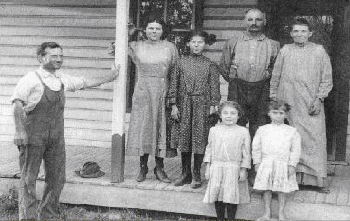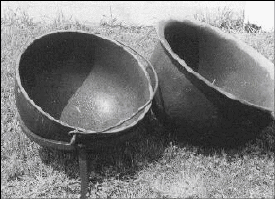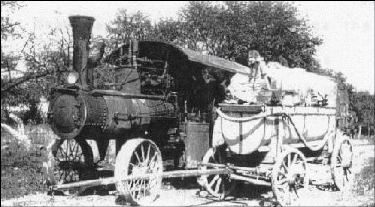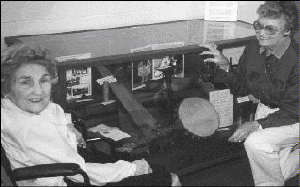This is
Rosa Bertsch Phillips’ family at their home on the Dixie Highway (25-A) north of
Sidney.
From left: Charley, Lena, Laura, Rosa (age 6), Pop, Olive, and Mom.

In 1904, March 27, Rosa Bertsch Phillips was born on a farm 3
1/2 miles south of Anna, Shelby County, Ohio, on the Dixie Highway…about 2 1/2 miles
south of the Greene Ville Treaty
Line. Her parents were John Bertsch and Mary Louise Kohler. They had eight children, Fred,
Charles, Frank, Harley, Laura, Lena, Rosa, and Alice. Rosa…named after Rosa Foster,
teacher at nearby Finkenbine
School. Mrs. Bertsch recently detailed her life in My Medicine-Show Man, an
as yet unpublished work as told to Betty Fridley of Anna. Rosa and Eddie for many years
performed in vaudeville, medicine show, and minstrel show performances. The following
excerpt from the book tells of Rosa’s childhood and how her family brought meat to
the table. She says it took four to five hogs a year for a family of ten.
"Every winter they butchered a hog for their meat, but the supply didn’t last
all year. Butchering was a community affair, as was threshing the wheat and oats a
neighborhood activity, also. The neighbors came in to help and stayed for supper. Of
course, Bertschs returned the favor and helped them with their butchering or threshing.
They had fresh meat from the hog that night for one big neighborly supper. Being a little
girl, Rosa had to stay in the house, mostly because it was a gory mess and the weather was
cold. Butchering was no place for a nosey little girl."
Iron kettles were
used in butchering hogs. The kettle on the left was suspended over a fire to prepare
scalding water.
The other kettle was used to render the fat.

But Rosa could tell you how it was done. On
a clear, cold day in the winter, John Bertsch would put a huge iron kettle of water on to
boil over an open fire out in the barnyard. The kettle hung from a very tall tripod made
of three wooden poles with a chain and a hook suspended from the top over the open fire on
the ground. They had to scald the hog in a big trough by pouring that hot water over it,
so they could easily scrape the outside of the carcass to remove the bristles and hair.
The hog scrapers they used looked like a metal saucer turned upside down with a wooden
handle fastened to it. The hog was really clean when they got finished.
Pop would use the same tripod hanger to suspend the hog after it was scraped so the men
could handle the hog more easily. They would slit the hog down the middle on the
underside, and use a spreader, which was a wooden stick, to hold the hind legs apart.
Someone with a big dishpan would catch the entrails.
Some pork was ground for sausage and stuffed into hog gut which had been washed and
washed and scraped. Then they would run water through the guts until they were as clean
and white as the driven snow. Rosa would butt in and help do the sausage for she had
watched so often from the window that she felt as though she could butcher a hog by
herself.
"They used as much of the insides of the hog as possible. Here’s where the
women came in. From the stomach they made tripe. After they scraped the stomach and washed
it clean, they stuffed it with chopped-up potatoes, carrots, and onions with lots of salt
and pepper, then boiled it in an iron pot. The meat on the head was used for hog pudding,
sometimes called head cheese. The meat was ground and stuffed in gut, too, then twisted
into a ring. Why it was shaped in a ring is a mystery, just custom. Different seasonings
were used in it, and it didn’t look like sausage, much finer in texture and had sort
of a gray color."
Young
Rosa Bertsch inspects the Lenhart threshing rig - a steam engine and water wagon.

"Bertschs also made pawenhaus by
cooking corn meal in the broth they got by boiling the bones. Pawenhaus was poured into a
pan and left to cool and then it would be solid. Later it would be sliced and fried to be
eaten with syrup. Farmers would make a meal on pawenhaus.
They never butchered beef, only pork, because they had no refrigeration and it was
easier to preserve and cure pork than beef. To preserve the hams, shoulders, and bacon as
long as possible and in case the weather got above freezing, they would be smoked in the
summer kitchen, which was a separate building behind the house. They used hickory wood to
give flavor. The building would be closed up real tight and then a fire was built on the
concrete floor. When Pop thought the hams were cured so that they wouldn’t spoil, he
took the hams and bacon slabs to the barn and hung them in the granary, which was the part
of the barn in which Pop stored seed wheat. The meat was hung from the rafters on huge
hooks. It was real dark in the there and the flies wouldn’t get on it. Mom always cut
off the edge of the slice of meat anyway when she cooked it.
When the Bertsch family had company, which was always unexpected because of lack of
communication, Mom would go out into the barn and get some ham. She’d have fried ham,
potatoes and gravy. Usually the company was relatives, the Bertsches who came from
Columbus, Ohio, about ninety miles away.
Pop made both smoked sausage and fresh sausage, but he didn’t cut any pork chops.
To preserve the fresh sausage he would put it in a crock and pour hot lard over it to seal
out the air. They made lard and kept it in the basement in 20-pound lard cans. To make the
lard, the men would cut the fat with hide still attached into small pieces. There were no
bristles because they had been scraped off first thing. They would throw the pieces into
the big iron kettle they used to heat the water to scald the hog, and cook the fat over
the open fire. It had to be stirred all the time or it would burn."
Below,
former medicine-show performer Rosa Phillips (left) of Anna reviews the Society’s
October, 1998,
Amos
Memorial Public Library exhibit of musical instruments she and her late husband Eddie
used in their 1920’s act.
Society member Betty Fridley (at right) collaborated on
Mrs. Phillips’ memoirs, "My Medicine-Show Man."

"They had wooden paddles with long
handles so the men could stand back from the heat and still stir the fat. After that the
cooked fat was put in a press and the lard squeezed out. The pieces of fat, some with rind
still on them, were left in the press in a large cake; these were the cracklins. They
could be cracked apart and with a little salt they were mighty good snackin. Those with
the rind were the best; they would last and last, like a piece of chewing gum. Cracklins
were crispy and crunchy. Butchering was hard work but it became a festivity when the
neighbors helped.
Pop grew potatoes in a patch that was almost a fourth mile long. In later years a
slight bend was taken out of the road (now County Road 25-A) and consequently, 25A now
runs over the potato patch. In the spring, Rosa and her younger sister, had to de-bug
those potato vines. The two little girls carried a can of coal oil (kerosene) in one hand
and a stick in the other hand. They’d knock the bugs off the vine into the can of
oil, which killed that old bug. Later, when the potatoes grew large and the vines started
to die, the potatoes were dug with a horse and a small plow. The same two little girls
would pick up potatoes all day till they could hardly sit or sleep. Girls never worked
outside unless they wore bonnets or old
hats, long black cotton stockings over their arms and legs; their necks had to be covered,
too. It was popular to be white and pretty, not tanned."

